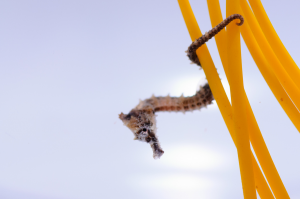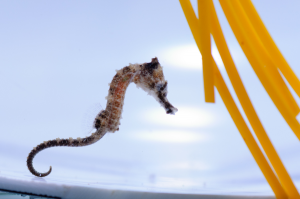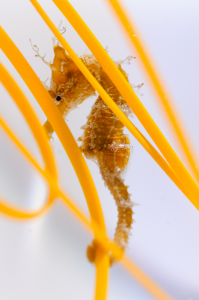Here at the Long Island Aquarium, one of my main responsibilities is our 400 gallon seahorse exhibit. It houses two different species of seahorses; Hippocampus erectus, and Hippocampus radia.One of the primary parts of keeping a seahorse exhibit, is always keeping a full collection of seahorses, by breeding and rearing more specimens. In this post I am going to tell you how we breed seahorses at the Long Island Aquarium, in hopes to assist some beginner seahorse breeders.
When it comes to breeding seahorses, it always helps to identify the males and females that are in the exhibit. Males have a brood pouch, which can be found in the lower front of the abdomen, right below the anal fin. Females do not have a brood pouch; instead they have an ovipositor, which they use to deposit their eggs into the males pouch. Once the male is pregnant, it can take up to 3 weeks for him to give birth. Seahorses give birth to an average of anywhere between 100-1000 juveniles. They can have as low of a birth rate as 5 juveniles born. Prior to birth, I will remove the male seahorse from the exhibit, and place him into a Labor tank. After birth this will be changed into a rearing tank for the juvenile seahorses.
While in labor, male seahorses will arch their back, moving back and forth, to release the juveniles into the water column. Once I believe that all of the seahorses have been released, I will put the male back onto exhibit. I then turn off the flow in the rearing tank, and turn on an airstone that is attached to the back wall of the tank, which will create an upwards flow, thus creating a kreisel. This will suspend juveniles in the water column which makes it much easier for them to catch their food, while still conserving much needed energy.

The first few days are the most crucial for survival. I see the most loss at this time. To insure the best survival rate, the first few days I only feed a mix of copepods, and rotifers, as brine shrimp (Artemia) is harder for the juveniles to digest. After 4-5 days I will begin to feed newly hatched Artemia nauplii enriched with algae. After about 2 months I will offer live mysids and cyclops. After they have began to eat these, I will offer frozen mysis to wean them off of live foods.
After the first few weeks, I will turn down the air flow and add in some structures that are a variety of colors. This will trigger some of the juveniles to change color as they grasp onto the brightly colored structures. Usually this will occur in about half of the seahorses, while the other half will remain black.

At this point I will separate them by color, to encourage them to stay the color they have become. The yellow seahorses usually go into a small exhibit to really impress guests, while the black seahorses will remain behind the scenes until they have become big enough to go out to the main exhibit. This will occur around 3 months. Around 1 year of age, the seahorses have reached sexual maturity, and will begin to start breeding. Thus, starting the breeding cycle all over again.









I am Emmanuel. I would like to know if seahorses can be raised for commercial purpose.